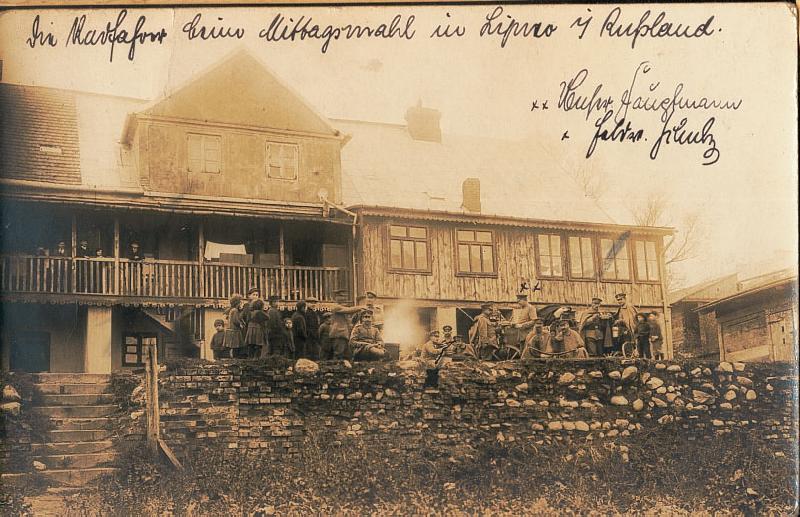
Lipno
Source: Slownik Geograficzny Krolestwa Polskiego - Warsaw 1881-1886 & other sources
Submitted by: Henryk Skrzypinski, From the PGS of California Newsletter 1999

Old postcard from Lipno, courtesy of Tomasz Wisniewski
L
ipno is a city located in the center of Dobrzyn-land, a country in Mazovia called so since the Middle Ages, after the Order of Dobrzyn Brothers settled here by Duke Conrad. The city is surrounded by hills of post glacial origin, 100-117 m. over the sea level, along a small river called Mien.O
n April 21, 1349, the Duke Vladislav invested a settlement called earlier Lippe with town rights. Later the Polish kings Vladislav Jagiello and his sons Alexander and Sigismund confirmed or issued new privileges of economic importance to the city. Lipno soon became an important trade and craftsmanship center. Merchants from Lithuania and Prussia cross Lipno on their way to Gniezno and Poznan bringing enormous quantities of fur-coats and cloth, for which they had to pay customs to the city's treasurer. Also the local craftsmen and dealers flourished. Breweries, mills, and bakeries developed. By that time, however, problems of fresh water appeared. The sources of river Mien were insufficient, sewage treatment did not exist. The Lipno population was decimated by epidemics called "Dispensation of Providence" in 1348, 1623, 1626-1629, and 1708-1709.M
ost dangerous for the city's existence were wars of the 17th and 18th centuries (Swedish invasions.) The invaders robbed and burned down the city, even Poland's own soldiers robbed and assaulted the people. These disasters broke Poland down. The kingdom was not able to defend itself, selfishness of the nobles and indifference towards their own country have encouraged Russia, Germany and Austria to incorporate parts of Poland during three partitions of 1772, 1793, and 1795. After the second partition, Lipno is incorporated to Germany. In 1618 a kingdom of Germany was established by a union between East Prussia and Brandenburg. The notion, "Prussian" became a synonym of strength and combativeness. King Friedrich II crowned himself to "King of Prussia" with its capital in Berlin. German rulers settled down farmers on captured territories. The king of Prussia ordered in 1804 town planning for Lipno which adjusted the urban development of this city.S
ince 1800 the number of population rises. Earlier there were just 480 inhabitants and 224 houses, but continuously immigrating farmers called "colonists," officials, officers, merchants, and craftsmen from Germany who settled down in the city and country, have increased the number of population during the next 15 years up to the double.N
apoleon Bonaparte's war against Prussia and Russia started 1806 liberated Poland for a few years. In 1815 according to the Vienna Congress of European powers a "Kingdom of Poland" was created with the Czar of Russia playing the role of the Polish king. Boundaries were changed. Lipno and Mazovia became part of this kingdom. The new state is since then often called "Congress Poland."I
n 1825 Lipno had 3008 inhabitants. A new Lutheran church was built in 1865-1868 after the outlay of the Polish architect Albert Lawrence Bobinski and constructed under the supervision of district chief inspector Louis Gosqlawski.A
trade treaty signed between Prussia and Russia in 1832, gave Lipno a good chance of development.T
he first World War brought liberty for Poland and Lipno after 125 years of occupation. On November 11, 1918, Poland was independent, but the revolutionary Soviet Russia tried to expand their ideology "over the dead body of Poland." The genius strategy of Joseph Pilsudski and the allied U.S. and French support, stopped the Bolshevik troops at the Lipno - Plock - Wloclawek line. This victory saved Poland and Europe for the next 20 years on August 15, 1920, and is called "The Miracle on the Vistula."A
special heroic defense of Lipno and Plock was organized by involvement of volunteers among teenagers from secondary schools who fought for their homeland. Lipno was at that time occupied again by the Russians but only for 7 days; soon Mozovia was free and the disbanded Bolshevik soldiers escaped to neutral East Prussia.I
n 1937, a railroad was constructed connecting Lipno directly with Warsaw and Torun. The same line goes through Skepe and Sierpc, enables the development in this part of Mazovia and makes Sierpc an important railroad junction. At that time 40% of the city population were Jews. During the Second World War all of them (whole families) were killed by the Nazi - Germans.Lipno City Population During The Past 200 Years:
1800 - 480 inhabitants
1825 - 3008
1939 - 12,018
1946 - 8,389
1991 - 14,300
![]()